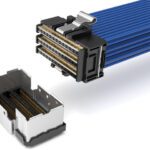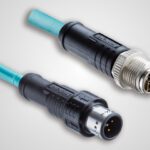Onanon’s Novel Manufacturing Approach Efficiently Produces Small-Volume Lots of Medical Connectors
Robots and customizable PCB materials help Onanon streamline production of medical connectors
The connector industry has evolved around a group of fundamental manufacturing processes:
- Stamping reel-to-reel
- Electroplating processes (either reel-to-reel or batch-plating in tanks)
- Molded housings
- Automated high speed machines that singulate contacts and insert them into the housings
The advantages of manufacturing connectors this way include high volume, low cost, and very high quality and consistency. Processes like this are problematic for low-volume connectors where set-up cost and time eliminate any cost advantage.
A second fundamental method of manufacturing is using turning technology on Swiss screw machines using rod stock to create pins and mating receptacles. These fast, efficient machines use rod stock fed past tools that create contacts one at a time. Screw machine connectors are commonly used in military, aero, and test connectors, and other applications that value reliability and robustness more than cost. Assembling contacts into housings is often done with vibrating systems that fill cavities with contacts that are subsequently seated, or by hand using an insertion/extraction tool. Another advantage of screw machined contacts is that they can be easily overmolded to create sealed, water-tight connectors.
Medical applications are unique in several aspects:
- They require high quality and reliability.
- Volume for a specific configuration is often small.
- Every end customer wants a unique connector configuration with special plastics, colors, shapes, and labeling.
- The result is a very high-mix/low volume manufacturing environment, which is not ideal for either stamped or screw machine processes.
A high-mix manufacturing environment calls for computer-controlled technology to optimize the process. Imagine many tiny, undedicated robots that can perform each manufacturing operation, including: contact placement, sealing, overmolding, conductor termination, inspection, and testing. The lines can run one batch of connectors, and then very quickly be reconfigured to make another, unrelated product. Onanon, in Milpitas, California, has developed just such a process.
Customizable PCB Materials Are Essential to the Process
They use inexpensive, easy-to-customize PCB material as the basis for most of their connectors. This approach allows them to produce the small boards that pop out of larger boards, optimized for high-volume manufacturing. These substrates can accept stamped or screw machined contacts. Then, they can be sealed, overmolded, and sealed again to become complete connectors. The process is easily expanded to add cable termination and cable boots. This whole process is especially good for producing single-use disposable products that can be sterilized for medical applications, keeping the entire manufacturing process in one building.
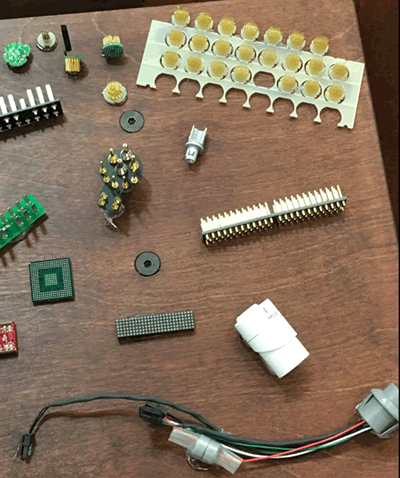
Selection of Onanon substrates showing the variety of applications, contacts, and shapes.
This kind of manufacturing process avoids the massive up-front tooling cost required for most conventional connectors, dramatically improving delivery of prototypes and first-production samples, speeding testing and qualification, and keeping production lead-times for many different connectors consistently short. They use computer-controlled X-Y machines with flexible tooling that is able to handle any PCB substrate presented to it, adding pins in custom configurations at very high speed, high quality, and consistency. Change-overs are very quick; just load a new program, tooling heads, and contact feeders — processes similar to those used by high-volume contract manufacturers to make electronic boards used in all sorts of electronic equipment. This kind of manufacturing process can produce small-volume lots of special connectors without having to invest in expensive molds or to dedicate equipment. They use a high level of automation to place pins, add solder preforms, and to place epoxy to seal the wafer. Automated pick-and-place machines can also add chips or passive components to make “smart connectors.”
Onanon’s processes are scaleable so that they can make very high volume cable assemblies cost effectively with high quality levels.
They can stitch any pattern of pins, accommodating, for instance, pogo pins into the substrate, press fit, or solder attach. Then, they overmold the housing with the desired features for orienting, polarizing, and latching. These substrates can accept a variety of screw machined parts, such as receptacle contacts, pins, or contacts with a receptacle on one side and a pin on the rear side.
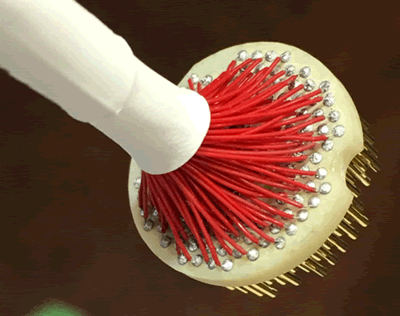
This high density array of soldered wires is terminated on a special rapid wire termination machine.
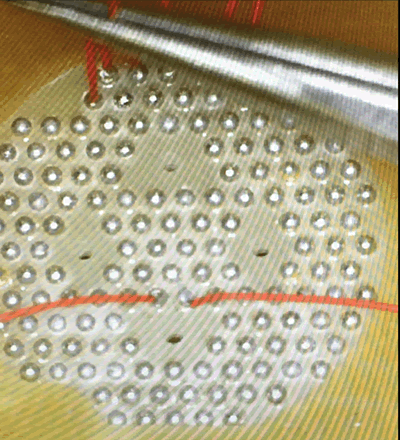
Operator view of solder field of an Onanon high-density connector.
Quick, Reliable Soldering
One industry challenge is how to solder many fine wires onto a dense array of contacts, which is typical of many sensor arrays used in ultrasound, x-ray, and MRI devices. The company has developed a machine to solder wires quickly with high reliability. The connector is placed in a fixture that is able to reflow one solder button at a time. A computer shows the operator where to put the wire. Then the wire is manually inserted into the liquid solder, which cools, and the next contact is heated to liquidus. The fixture then validates that the wire is in the correct place with a low-resistance connection before proceeding to the next step. Hipot testing assures that there are no shorts. This capability is extremely helpful when dealing with the very fine conductors often found in medical sensor applications as small as 50 AWG.
By using this strategic approach the company asserts it is one of the largest custom OEM manufacturers in North America.
Recently posted:
[related_posts limit=”10″]

